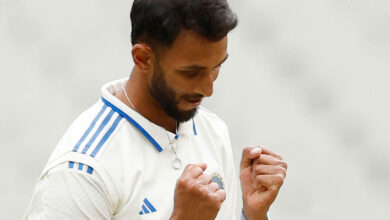Aid for spinners or assance for seamers? What will the pink-ball Test in Bengaluru offer bowlers

Crimson dusk crawled in, shading the silvery skies above Bangalore. The floodlights quivered into life, adding varied hues to the palette of colours spread across the sprawling skies. In the vicinity of the Chinnaswamy Stadium, lights from stray sky-risers began to flicker like dant stars. It was not dark, it was not bright either.
It was not until the skies slipped into the twilight that the cream of Indian batsmen began to bat. Until then, they were content playing football and rondo with a tennis ball. Then one after the other, they slowly hit the nets, right under the floodlights.
India’s vice-captain Jasprit Bumrah, center, interacts with batting coach Vikram Rathour, left, and head coach Rahul Dravid during a training session. (AP Photo)
First, were Mayank Agarwal and Shubman Gill, both keen on the back-foot, driving and cutting enthusiastically. Shreyas Iyer, who took over after Gill was tired, was in a mood for violence, stepping down to the seamers and spinners, a reflection of the golden touch. then Hanuma Vihari had begun to exude his compactness, blunting deliveries from Jasprit Bumrah to Virat Kohli. In the nets on the other corner of the ground, Rishabh Pant was belting the throw-downs pelted at him.
An hour later, Kohli strode in and imperiously lofted-drove Axar Patel. Of late, he has been troubled the lefties—Ajaz Patel for example—but here he was emphatic in thwarting them.
All was smooth until they headed for the slip-catching session, where the ball flew finely and speedily to the closely-spaced cordon. Agarwal, manning the third slip, was the repeat culprit, often late to judge or react. A few times, the ball popped out of Rohit Sharma’s palms too. Just as how much the pink ball swung or spun, the velocity and trajectory of the edges were closely watched. From how it looks to how it feels, it takes some getting used to.
India’s Virat Kohli reacts after inspecting the pitch during a training session. (AP Photo)
Thus, it was just another routine, serious nets. At various points of time, they dwelt on the mysteries of the sky, peering deeply into it like philosophers lost in a heavy thought. Some of them hurled the pink ball around to feel it — though of the same weight, it tends to feel heavier, like a hockey ball, Kohli had once observed.
As the session wore on, the gradients of the ball seemed to change, from bright pink to blazing pink and then, as man-made light became more pronounced a smudge of fluorescence that seemed to draw patterns in the path it traced, as when you look at something dazzling. The pink ball was an object of much attention. It’s still an acquaintance, not yet a friend.
Though Day and Night Tests with the pink ball have become mainstream, a sense of mystery still lurks. These are early days to sketch conclusive patterns, or that there are no discernible patterns, apart from the consensus that they are bowler friendlier than the traditional wine-red cherry. Not a single of the 18 matches have ended in a draw; just a half of it has extended beyond the fourth day. Two digits scores are aplenty, sub-150 totals in abundance. India have featured in three, losing in Adelaide and winning twice at home.
Contrasting victories
Two victories were starkly contrasting, apart from the general theme that both combined lasted a mere four-and-half-a-days. Pacers blew Bangladesh away at the Eden Gardens, as Ishant Sharma, Mohammed Shami and Umesh Yadav allied to pick all the wickets.
Seamers purchased extravagant movement and bounce, beat their edges and pinged their heads, four different Bangladesh batsmen were struck on their helmets. As many as nine—that is one third of the wickets—fell with both teams facing the new ball in the middle session while batting was comparatively stress-free in the late sessions, thanks to dew and the shorter duration of the twilight period in Kolkata in November.
Indian players participate in a training session ahead of the second Test in Bengaluru. (AP Photo)
Players made careful observations. Sharma said even the semi-new ball swung; Umesh carped about the lack of reverse swing.
The roles reversed in Ahmedabad. Spinners wreaked havoc, plucking twenty eight of the thirty wickets. Axar Patel grabbed 11 and Joe Root snared a rare five-for in a game that was wrapped up in 140 overs. For spinners, some balls turned outrageously, mostly those that landed on the seam; some skidded straight, mostly when it landed on the glossy part of the ball. “When you tried to put a lot of revs, it probably wasn’t rotating as much on the seam as I thought the red ball was rotating. The balance of the ball seemed very different to that of the red ball,” Ravi Ashwin had observed.
Dew unlikely
So what does Bangalore hold? Aid for spinners or assance for seamers? A lot of variables are in play. For instance, the nature of the soil; Motera’s is more clayey red soil that abets low-slow turners, Eden Gardens’ sandier black soil engineers more swing and consent bounce. Chinnaswamy has red laterite soil that holds up the surface and helps maintain consent bounce and a hint of swing in the morning session. But the pre-summer heat could mean the pitch could dry up and crumble. There would not be any dew either, unlike in Eden Gardens, implying that batting under lights would be difficult.
As of now, the surface looked brown with a tinge of grass here and there. But like the skies, it could quickly change its gradients. The Chinnaswamy has seen all sorts—from swingers to square turners, and dead wickets too. But usually, batsmen tend to enjoy the first couple days. All these factors make the third pink ball Test in the country engrossing. And another layer of pink-ball mystery shall be unravelled.







